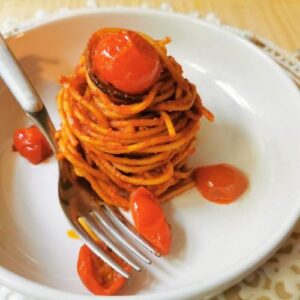
Spaghetti all'Assassina (Assassin's Spaghetti)
The word ‘assassina’ means assassin or killer in English. However, the name of this killer pasta doesn’t refer to a criminal. It is most probably used as a colloquial way to say ‘impressive’, a bit like saying ‘you killed it’ to someone who’s done something really well. Or, the name refers to the fact that this dish can be quite spicy.
Ingredients
- 12-ounces thin spaghetti or vermicelli
- 14-ounces tomato puree
- 1 - 2 tbsp. tomato paste
- ½ cup extra virgin olive oil
- 2 - 3 garlic cloves, peeled; 1 - 2 chopped and 1 left whole
- 1 fresh peperoncino (red chili pepper) or ½ tbsp. red chili flakes, or to taste
- 1 - 2 tsp. granulated sugar
- Salt and pepper, to taste
- 12 cherry tomatoes, optional
Instructions
- Peel the garlic and finely chop 1 - 2 cloves.
- If using a fresh red chilli, cut into small pieces; remove the seeds if you prefer it less spicy.
- Prepare a broth made with water, 2/3 of the tomato purée; should be 1:1, the tomato paste and salt; bring to a boil and simmer.
- The broth should to be a bright red and tasty, but still a broth; the broth needs to be hot when added to the spaghetti, otherwise, the cooking temperature, for the pasta, will be lowered.
- In a cast iron pan, add ½ cup of olive oil, one whole garlic clove, one chopped garlic clove and red chili pepper seasoning according to spice level desired for the spaghetti.
- Cook the garlic, over a high heat, until golden; remove the whole garlic clove and pour in the 1/3 of undiluted tomato purée.
- To temper the acidity from the tomatoes, add 1 tsp. granulated sugar.
- Spread the puree over the whole pan with a wooden spoon and let it reduce and thicken slightly.
- At this point, put the uncooked spaghetti in the pan, distributing the pasta so it lies on top of the sauce; the puree will spit when first poured into the pan so take care not to get burned.
- Wait for the underside of the spaghetti to start caramelizing before turning it over; this must be done carefully, a little at a time using a spatula.
- Let the otherside of the spaghetti start to crisp a little and then pour in a ladle of the hot tomato broth; it’s better not to pour it over the spaghetti but to add it to the sides of the pan.
- The spaghetti should start to soften enough to move around and stir gently with a wooden spoon.
- Move any pasta strands that might have stuck to the bottom of the pan and allow the tomato broth to spread.
- Once the tomato broth has reduced and the spaghetti starts to stick a little again, add more broth.
- Keep repeating adding tomato broth and stirring the spaghetti until the spaghetti is coated in the sauce and cooked; if you run out of tomato broth, you can add a little water.
- When finished, this dish is relatively dry and crispy, not saucy.
- Add the optional cherry tomatoes (see note below).
- Serve spaghetti all’assassina immediately topped with Parmigiano, stracciatella or just as is.
Notes
I added cherry tomatoes which I had first sautéed in the iron pan before starting on the pasta. I removed them from the pan and then just added them back when my spaghetti all’assassina was ready.
This recipe is vegan as is. If you add Italian Parmigiano it won’t be vegetarian as this cheese is made with animal rennet. Use a vegetarian cheese for a vegetarian version.
This recipe is best made in an iron pan.
Leftovers keep well in a sealed container in the refrigerator for 2 - 3 days and can be re-heated in a skillet with a little olive oil and water.